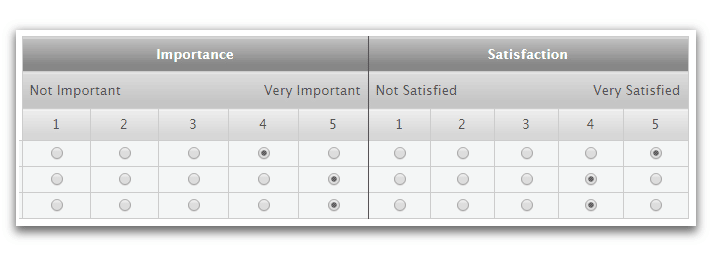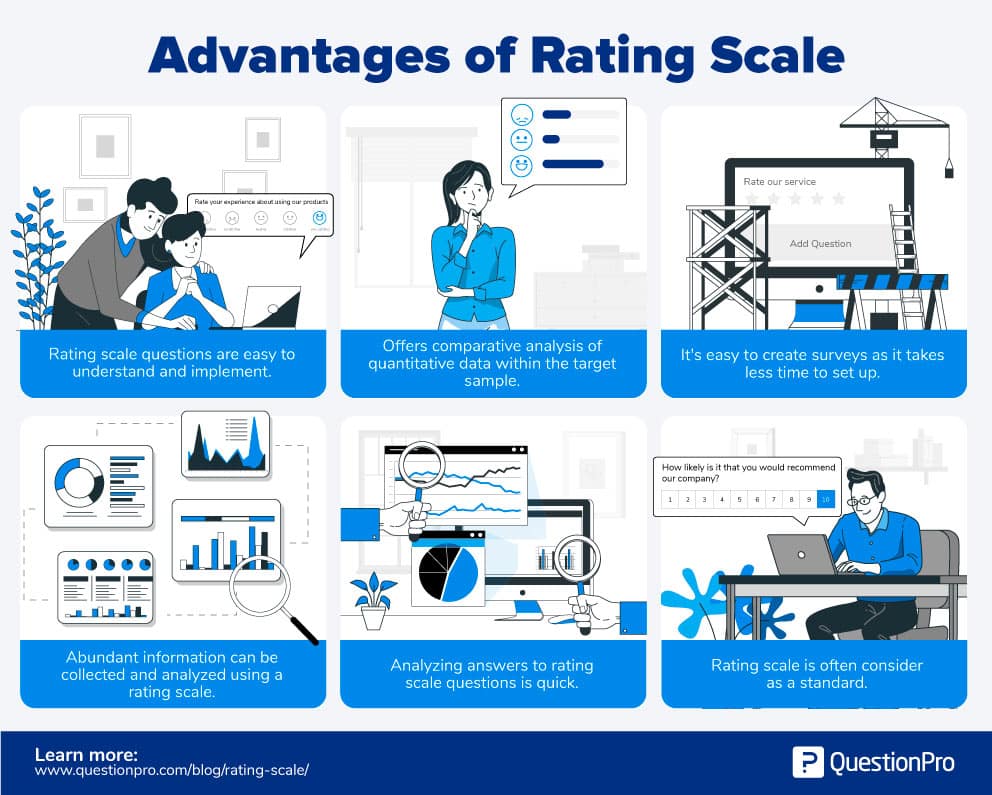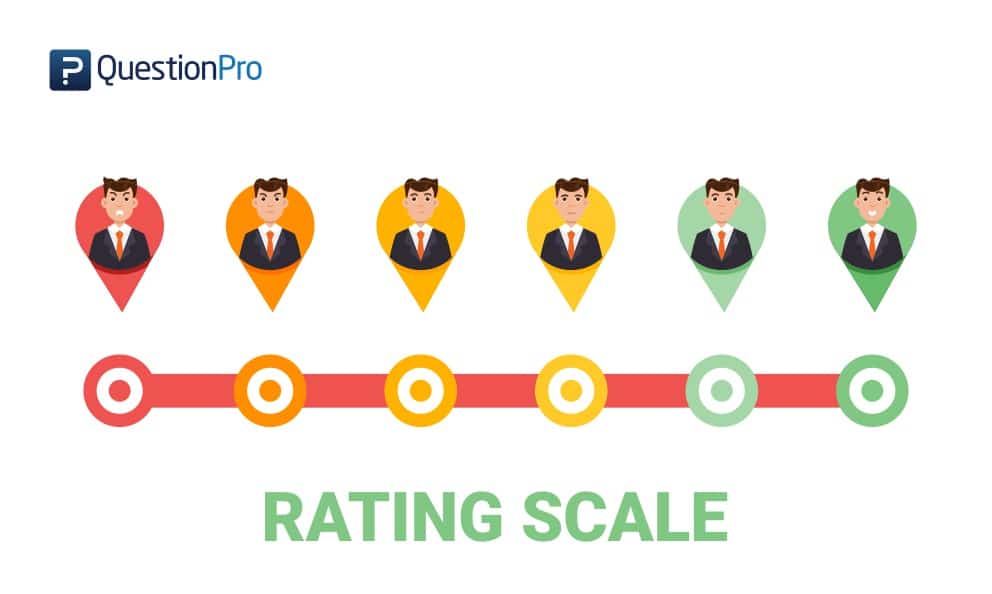A Scale Helps You Determine
Rating Scale Definition
Rating calibration is divers as a closed-ended survey question used to correspond respondent feedback in a comparative grade for specific item features/products/services. It is one of the nearly established question types for online and offline surveys where survey respondents are expected to charge per unit an attribute or feature. Rating calibration is a variant of the popular multiple-pick question which is widely used to gather information that provides relative data nigh a specific topic.
Researchers use a rating scale in inquiry when they intend to acquaintance a qualitative measure with the various aspects of a product or feature. Generally, this scale is used to evaluate the performance of a production or service, employee skills, client service performances, customer-starting time strategy, processes followed for a particular goal etc. Rating scale survey question tin can exist compared to a checkbox question just rating scale provides more information than just Yes/No.
Types of Rating Scale
Broadly speaking, rating scales can be divided into two categories: Ordinal and Interval Scales.
An ordinal scale is a calibration the depicts the answer options in an ordered way. The deviation between the ii answer option may non be calculable but the respond options will always be in a certain innate order. Parameters such as mental attitude or feedback can be presented using an ordinal scale.
Acquire more than: Ordinal Data
An interval scale is a scale where non simply is the order of the reply variables established merely the magnitude of difference between each answer variable is also calculable. Accented or true cipher value is not present in an interval scale. Temperature in Celsius or Fahrenheit is the most popular example of an interval scale. Net Promoter Score , Likert Scale , Bipolar Matrix Table are some of the virtually constructive types of interval calibration.
Larn more: Interval Data
At that place are four main types of rating scales which can be suitably used in an online survey:
- Graphic Rating Calibration
- Numerical Rating Calibration
- Descriptive Rating Calibration
- Comparative Rating Scale
- Graphic Rating Scale: Graphic rating scale indicates the reply options on a scale of 1-iii, 1-5, etc. Likert Calibration is a popular graphic rating scale instance. Respondents tin select a particular pick on a line or scale to depict rating. This rating scale is often implemented by Hr managers to conduct employee evaluation .

- Numerical Rating Scale: Numerical rating calibration has numbers as answer options and non each number corresponds to a feature or meaning. For instance, a Visual Analog Calibration or a Semantic Differential Scale tin be presented using a numerical rating scale.


- Descriptive Rating Calibration: In a descriptive rating scale, each answer pick is elaborately explained for the respondents. A numerical value is not always related to the respond options in the descriptive rating scale. There are certain surveys, for example, a customer satisfaction survey , which needs to draw all the answer options in particular so that every customer has thoroughly explained data almost what is expected from the survey.
- Comparative Rating Scale: Comparative rating calibration, as the name suggests, expects respondents to answer a item question in terms of comparison, i.e. on the basis of relative measurement or keeping other organizations/products/features as a reference.
Examples of Rating Scale Questions
Rating calibration questions are widely used in customer satisfaction every bit well equally employee satisfaction surveys to gather detailed information. Here are a few examples of rating calibration questions –
- Degree of Understanding: An organization has been intending to improve the efficiency of their employees. Afterward organizing multiple courses and certifications for the employees, the direction decides to conduct a survey to know whether employees resonate with their ideology backside these certifications. They can use a rating scale question such as Even Likert Calibration or Odd Likert Scale to evaluate the degree of understanding.
- 5 Betoken Likert Scale

- Customer Experience: It is important to collect information most customer experience. Information technology is important for organizations to gather existent-time details about product or service buy experiences. A rating scale question such as a Semantic Differential Scale tin aid the organization's management to collect and analyze data about client experience.
-
- Semantic Differential Calibration

- Analyze make loyalty: Organizations thrive on client loyalty towards their brand. But make loyalty is a factor which needs to be regularly monitored. Using a rating scale question such every bit Net Promoter Score can help organizations in garnering real-time details virtually customer loyalty and brand shareability. A rating question: "On a scale of 0-x, considering your purchasing experience, how likely are you to recommend our brand to your friends and colleagues?" can be constructive in monitoring client satisfaction and loyalty.

Uses of Rating Scale
- Gain relative data near a particular subject: In a sample size of 1000 individuals, each individual will have a different outlook towards a topic. Gathering comparative information most satisfaction levels, the frequency of use, loyalty and many other such parameters.
- Compare and analyze data: Researchers can collect unbiased information from the target audition and analyze that using online survey softwares such equally QuestionPro. If a rating scale question is used across a considerable sample size, at that place are chances that the margin of fault in obtained data can be reduced or eliminated.
- Measure out one important production/service element: There are surveys where certain topics demand to be addressed specifically, in order to understand the target market in a better manner. Rating scales tin be implemented in such cases where in that location are multiple important elements which are to be analyzed. For example, to measure caste of understanding, frequency, satisfaction etc.
Advantages of Rating Calibration

- Rating calibration questions are like shooting fish in a barrel to understand and implement.
- Offers a comparative assay of quantitative data within the target sample for researchers to make well-informed decisions.
- Using graphic rating scales, it is easy for researchers to create surveys equally they consume the to the lowest degree time to configure.
- Abundant information can exist collected and analyzed using a rating scale.
- The analysis of answer received for rating scale questions is quick and less time-consuming.
- Rating calibration is often considered to a standard for collecting qualitative and quantitative information for research.
A Scale Helps You Determine,
Source: https://www.questionpro.com/blog/rating-scale/
Posted by: burgessnatch1943.blogspot.com



0 Response to "A Scale Helps You Determine"
Post a Comment